Railway Freight Demand Forecasting Based on Multiple Factors: Grey Relational Analysis and Deep Autoencoder Neural Networks
Abstract
1. Introduction
- Stronger representation learning ability: Deep automatic encoders can adaptively learn high-level feature representations. This makes it possible to distinguish the differences between the categories and to improve the accuracy of the model;
- Non-linear modeling capability: Deep automatic encoders adopt a multilayered non-linear transformation, which can better approximate the non-linear function, thus improving the performance of the model;
- Stronger generalization ability: Deep automatic encoders can map raw data to higher-level, more abstract representation spaces, improving the model’s generalizability.
2. Methodology
2.1. The Problem Formulation
2.2. The GRA-DAE-NN Model
- Step 1. Determine the characteristic sequence ;
- Step 2. Determine the correlation factor sequence ;
- Step 3. The reference and comparison sequences are normalized. The dimensionless characteristic sequence and the dimensionless correlation factor , ;
- Step 4. Find the correlation coefficient between the reference sequence and comparison sequence .
- a.
- Encoder
- b.
- Decoder
- c.
- Training process
2.3. Prediction Method Based on GRA-DAE-NN
3. Case Study
3.1. Data Source
3.2. Parameter Settings
3.3. Analysis and Comparison of Forecast Results
3.3.1. Results of Explanatory Variables Select
3.3.2. Forecast Results Analysis
3.3.3. Results Comparison between GRA-DAE-NN and Baseline Models
- (1)
- ARIMA (autoregressive integrated moving average): ARIMA regards the data series formed by the prediction object over time as a random sequence and uses a certain mathematical model to approximate the series [39];
- (2)
- SVR (support vector regression): SVR is a time series model that uses the relationship between historical and future data to predict future data [40];
- (3)
- GRU (gated recurrent unit): GRU is a learning algorithm based on a recurrent neural network, which has a sequence-to-sequence structure and is usually used for time series analysis [41];
- (4)
- FC-LSTM (fully connected LSTM): It is a classic RNN that learns time series and predicts through fully connected neural networks. In this paper, the hidden layer is set to be two layers; the hidden units are 32 and 64, respectively, the learning rate is 0.001, and the batch size is 64 [42];
- (5)
- DNN (deep neural network): It uses DNN to extract railway freight demand characteristics and predict railway freight demand [43];
- (6)
- FNN (feedforward neural networks): FNN is the most basic type of neural network, consisting of an input layer, hidden layer, and output layer, suitable for most classification and regression problems [44];
- (7)
- GRNN (general recurrent neural networks): GRNN calculates the correlation density function between variables and carries out regression, making it suitable for time series prediction [45].
3.3.4. Ablation Study
3.3.5. Explanatory Variable Analysis
4. Conclusions
- The improved GRA-DAE-NN model has high predictive accuracy and interpretability for predicting the trend of target changes and can select explanatory variables related to railway freight demand for better prediction. It can not only accurately predict the trend of changes in railway freight demand but also determine the key factors and contribution priorities that affect its changes;
- According to the analysis of the influencing factors by GRA, the core indicators in the explanatory variables for railway freight demand prediction, such as coal production, petroleum production, grain production, daily production of freight locomotives, etc., have the best explanatory power for the trend changes in railway freight demand. Railway policymakers can focus on these indicators to adjust their transportation organization strategies in response to changing demand;
- Through a case study of the Chinese railway freight market from 2000 to 2018 and comparisons with other mainstream prediction models, it is found that the improved GRA-DAE-NN model has higher prediction accuracy. The prediction accuracy of the GRA-DAE-NN model is 97.79%, higher than that of other models such as ARIMA, SVR, FC-LSTM, DNN, FNN, and GRNN, which have prediction accuracies of 94.04%, 95.38%, 96.65%, 95.52%, 92.58%, and 97.32%, respectively. The ablation experiment confirmed the efficiency of the GRA module. After using GRA to filter the explanatory variables, the prediction model exhibited greater precision.
Author Contributions
Funding
Institutional Review Board Statement
Informed Consent Statement
Data Availability Statement
Conflicts of Interest
References
- Brkić, R.; Adamović, Ž.; Bukvić, M. Modeling of Reliability and Availability of Data Transmission in Railway System. Adv. Eng. Lett. 2022, 1, 136–141. [Google Scholar] [CrossRef]
- Zhang, D.L.; Peng, Y.J.; Xu, Y.; Du, C.Y.; Zhang, Y.M.; Wang, N.; Chong, Y.H.; Wang, H.W.; Wu, D.H.; Liu, J.T. A high-speed railway network dataset from train operation records and weather data. Sci. Data 2022, 9, 244. [Google Scholar] [CrossRef]
- Xu, G.M.; Zhong, L.H.; Wu, R.F.; Hu, X.L.; Guo, J. Optimize train capacity allocation for the high-speed railway mixed transportation of passenger and freight. Comput. Ind. Eng. 2022, 174, 108788. [Google Scholar] [CrossRef]
- Tian, Z.D.; Li, S.J.; Wang, Y.H.; Sha, Y. A prediction method based on wavelet transform and multiple models fusion for chaotic time series. Chaos Solitons Fractals 2017, 98, 158–172. [Google Scholar]
- Luo, Y.; Cai, H.X.; Mao, Y.; Ding, Y.; Zhao, X.Q.; Wei, Z. Enhanced Smith predictor by Kalman filter prediction for the charge-coupled device-based visual tracking system. Opt. Eng. 2022, 61, 054107. [Google Scholar] [CrossRef]
- Hina, H.; Abbas, F.; Qayyum, U. Selecting correct functional form in consumption function: Analysis of energy demand at household level. PLoS ONE 2022, 17, e0270222. [Google Scholar] [CrossRef]
- Y, N.N.; Ly, T.V.; Son, D.V.T. Churn prediction in telecommunication industry using kernel Support Vector Machines. PLoS ONE 2022, 17, e0267935. [Google Scholar] [CrossRef]
- Binhimd, S.; Almalki, B. Bootstrap prediction intervals. Appl. Math. Sci. 2018, 12, 841–848. [Google Scholar] [CrossRef]
- Kandasamy, A.; Sundaram, M. Content Based Image Retrieval using Modified Histogram with user Feedback Wavelet Analysis Method. Int. J. Comput. Inf. Technol. 2021, 2, 13. [Google Scholar]
- Gao, Y. Prediction Strategy Method of Short-term Network Public Opinion Based on Improved Chaos Theory. J. Chongqing Univ. Technol. (Nat. Sci.) 2019, 33, 171–176. [Google Scholar]
- Iwana, B.K.; Uchida, S. An empirical survey of data augmentation for time series classification with neural networks. PLoS ONE 2021, 16, e0254841. [Google Scholar] [CrossRef]
- LeCun, Y.; Bengio, Y.; Hinton, G. Deep learning. Nature 2015, 521, 436–444. [Google Scholar] [CrossRef]
- Gao, H.; Yang, W.X.; Wang, J.W.; Zheng, X.Y. Analysis of the Effectiveness of Air Pollution Control Policies Based on Historical Evaluation and Deep Learning Forecast: A Case Study of Chengdu-Chongqing Region in China. Sustainability 2021, 13, 206. [Google Scholar] [CrossRef]
- Alshboul, O.; Shehadeh, A.; Almasabha, G.; Almuflih, A.S. Extreme Gradient Boosting-Based Machine Learning Approach for Green Building Cost Prediction. Sustainability 2022, 14, 6651. [Google Scholar] [CrossRef]
- An, G.Q.; Jiang, Z.Y.; Chen, L.B.; Cao, X.; Li, Z.; Zhao, Y.Y.; Sun, H.X. Ultra Short-Term Wind Power Forecasting Based on Sparrow Search Algorithm Optimization Deep Extreme Learning Machine. Sustainability 2021, 13, 10453. [Google Scholar] [CrossRef]
- Tanner-Smith, E.E.; Tipton, E. Robust variance estimation with dependent effect sizes: Practical considerations including a software tutorial in Stata and SPSS. Res. Synth. Methods 2014, 5, 3–30. [Google Scholar] [CrossRef]
- Wu, W.T.; Li, P.; Liu, R.H.; Jin, W.Z.; Yao, B.Z.; Xie, Y.Q.; Ma, C.X. Predicting peak load of bus routes with supply optimization and scaled Shepard interpolation: A newsvendor model. Transp. Res. Part E—Logist. Transp. Rev. 2020, 142, 102041. [Google Scholar] [CrossRef]
- Wu, W.T.; Xia, Y.S.; Jin, W.Z. Predicting Bus Passenger Flow and Prioritizing Influential Factors Using Multi-Source Data: Scaled Stacking Gradient Boosting Decision Trees. IEEE Trans. Intell. Transp. Syst. 2021, 22, 2510–2523. [Google Scholar] [CrossRef]
- Huang, C.Y.; Hsu, C.C.; Chiou, M.L.; Chen, C.L. The main factors affecting Taiwan’s economic growth rate via dynamic grey relational analysis. PLoS ONE 2020, 15, e0240065. [Google Scholar] [CrossRef]
- Wang, M.; Wang, W.; Wu, L.F. Application of a new grey multivariate forecasting model in the forecasting of energy consumption in 7 regions of China. Energy 2022, 243, 123024. [Google Scholar] [CrossRef]
- Wu, L.F.; Gao, X.H.; Xiao, Y.L.; Yang, Y.J.; Chen, X.N. Using a novel multi-variable grey model to forecast the electricity consumption of Shandong Province in China. Energy 2018, 157, 327–335. [Google Scholar] [CrossRef]
- Huang, Y.S.; Shen, L.; Liu, H. Grey relational analysis, principal component analysis and forecasting of carbon emissions based on long short-term memory in China. J. Clean. Prod. 2019, 209, 415–423. [Google Scholar] [CrossRef]
- Huang, S.Q.; Xu, H.L.; Liu, C.J. Application of Electro-Optic Rotary Encoder in Automatic Production Line. Adv. Disp. 2006, 11, 63–65. [Google Scholar]
- Dai, Y.; Ji, E.; Yao, Y. Stacked Auto-Encoder Driven Automatic Feature Extraction for Web-Enabled EEG Emotion Recognition. In Proceedings of the 2021 7th Annual International Conference on Network and Information Systems for Computers (ICNISC), Guiyang, China, 23–25 July 2021; pp. 991–997. [Google Scholar]
- Wang, H.; Wu, Z.; Xing, E.P. Removing Confounding Factors Associated Weights in Deep Neural Networks Improves the Prediction Accuracy for Healthcare Applications. In Proceedings of the Pacific Symposium on Biocomputing, Kohala Coast, HI, USA, 3–7 January 2019. [Google Scholar]
- Zhang, L.; Luo, H.; Hu, S.S.; Wang, J.; Kou, Z. Application of Sparse Automatic Encoder in Error Prediction of Multidimensional Electric Energy Metering. Process Autom. Instrum. 2018, 39, 28–31. [Google Scholar]
- Cao, H.; Chen, L.; Si, J.B.; Ren, J.L. Singular Value Decomposition and Sparse Automatic Encoder for Bearing Fault Diagnosis. Comput. Eng. Appl. 2019, 55, 257–262. [Google Scholar]
- Wu, L.M.; Lu, J.B.; Liu, C.X. A Recommendation Algorithm Based on Denoising Autoencoders. Comput. Mod. 2018, 3, 78–82. [Google Scholar]
- Teruna, C.; Avallone, F.; Casalino, D.; Ragin, D. Numerical investigation of leading-edge noise reduction on a rod-air Petroleum configuration using porous materials and serrations. J. Sound Vib. 2020, 494, 115880. [Google Scholar] [CrossRef]
- Singh, S.K.; Goyal, A. A Stack Autoencoders Based Deep Neural Network Approach for Cervical Cell Classification in Pap-Smear Images. Recent Adv. Comput. Sci. Commun. 2021, 14, 62–70. [Google Scholar] [CrossRef]
- Uzen, H.; Turkoglu, M.; Hanbay, D. Multi-dimensional feature extraction-based deep encoder-decoder network for automatic surface defect detection. Neural Comput. Appl. 2022, 35, 3263–3282. [Google Scholar] [CrossRef]
- Khouloud, S.; Ahlem, M.; Fadel, T.; Amel, S. W-net and inception residual network for skin lesion segmentation and classification. Appl. Intell. 2022, 52, 3976–3994. [Google Scholar] [CrossRef]
- Yang, H.; Huang, C.; Wang, L.; Luo, X. An Improved Encoder-Decoder Network for Ore Image Segmentation. IEEE Sens. J. 2021, 21, 11469–11475. [Google Scholar] [CrossRef]
- Song, W.; Zhang, Y.X.; Park, S.C. A novel deep auto-encoder considering energy and label constraints for categorization. Expert Syst. Appl. 2021, 176, 114936. [Google Scholar] [CrossRef]
- Geng, L.; Zhang, T.; Zhao, P. Prediction of LS-SVM Railway Freight Volume Based on Grey Correlation Analysis. J. Railw. 2012, 34, 1–6. [Google Scholar]
- Cai, B.; Xia, J. A novel artificial neural network method for biomedical prediction based on matrix pseudo-inversion. J. Biomed. Inform. 2014, 48, 114–121. [Google Scholar] [CrossRef]
- Besinovic, N. Resilience in railway transport systems: A literature review and research agenda. Transp. Rev. 2020, 40, 457–478. [Google Scholar] [CrossRef]
- Li, Q.L.; Rezaei, J.; Tavasszy, L.; Wiegmans, B.; Guo, J.; Peng, Q. Customers’ preferences for freight service attributes of China Railway Express. Transp. Res. Part A Policy Pract. 2020, 142, 225–236. [Google Scholar] [CrossRef]
- Saxena, A.; Yadav, A.K. Examining the Effect of COVID-19 on rail freight volume and revenue using the ARIMA forecasting model and assessing the resilience of Indian railways during the pandemic. Innov. Infrastruct. Solut. 2022, 7, 348. [Google Scholar] [CrossRef]
- Wang, T. An Intelligent Passenger Flow Prediction Method for Pricing Strategy and Hotel Operations. Complexity 2021, 2021, 5520223. [Google Scholar] [CrossRef]
- Yu, J. Short-term Airline Passenger Flow Prediction Based on the Attention Mechanism and Gated Recurrent Unit Model. Cogn. Comput. 2022, 14, 693–701. [Google Scholar] [CrossRef]
- Lin, S.; Tian, H. Short-Term Metro Passenger Flow Prediction Based on Random Forest and LSTM. In Proceedings of the 2020 IEEE 4th Information Technology, Networking, Electronic and Automation Control Conference (ITNEC), Chongqing, China, 12–14 June 2020. [Google Scholar]
- Yang, X.; Xue, Q.C.; Ding, M.L.; Wu, J.J.; Gao, Z.Y. Short-term prediction of passenger volume for urban rail systems: A deep learning approach based on smart-card data. Int. J. Prod. Econ. 2021, 231, 107920. [Google Scholar] [CrossRef]
- Saadaoui, F.; Saadaoui, H.; Rabbouch, H. Hybrid Feedforward ANN with NLS-based regression curve fitting for US air traffic forecasting. Neural Comput. Appl. 2020, 32, 10073–10085. [Google Scholar] [CrossRef]
- Guo, Z.D.; Fu, J.Y. Prediction Method of Railway Freight Volume Based on Genetic Algorithm Improved General Regression Neural Network. J. Intell. Syst. 2019, 28, 835–848. [Google Scholar] [CrossRef]

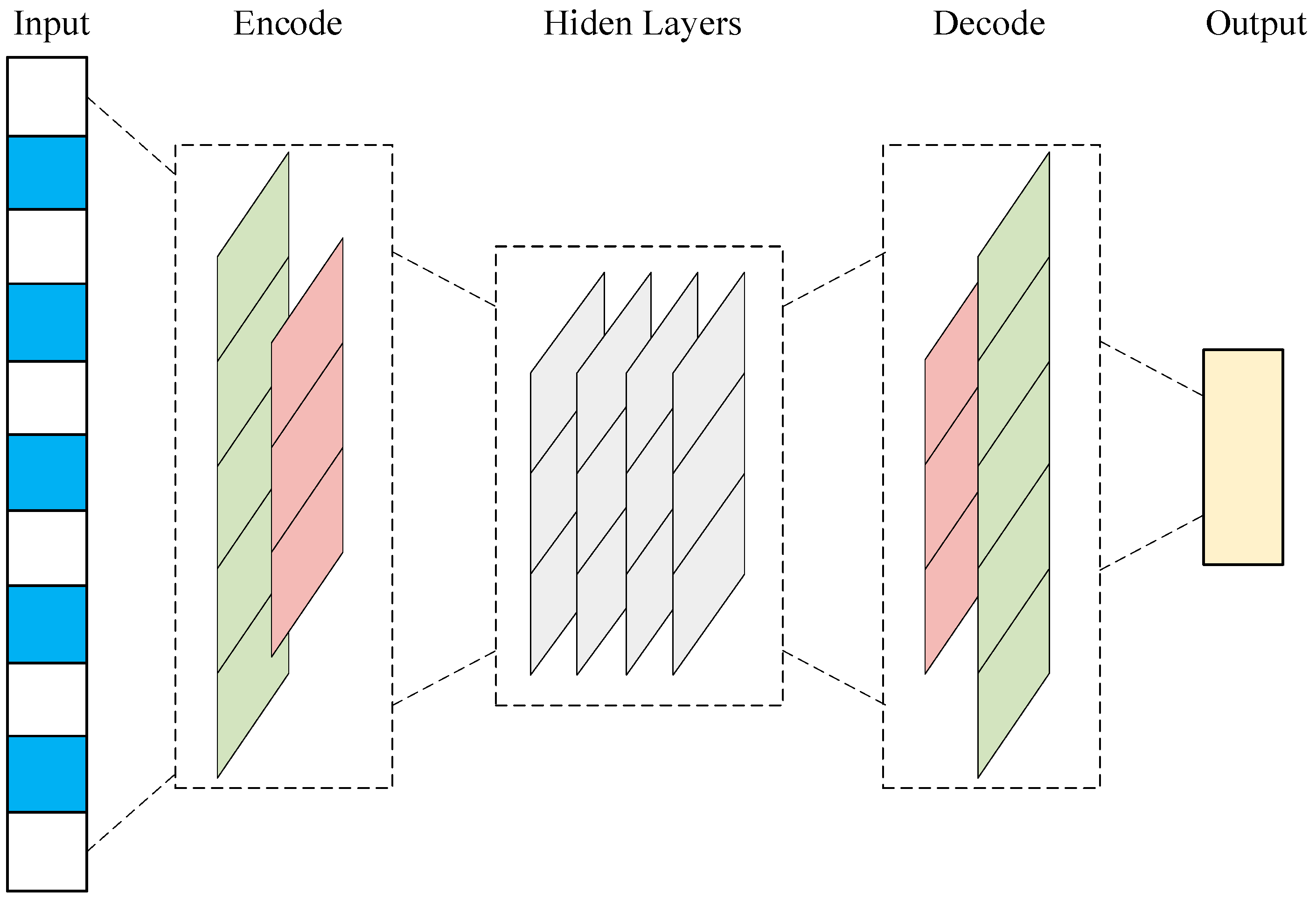
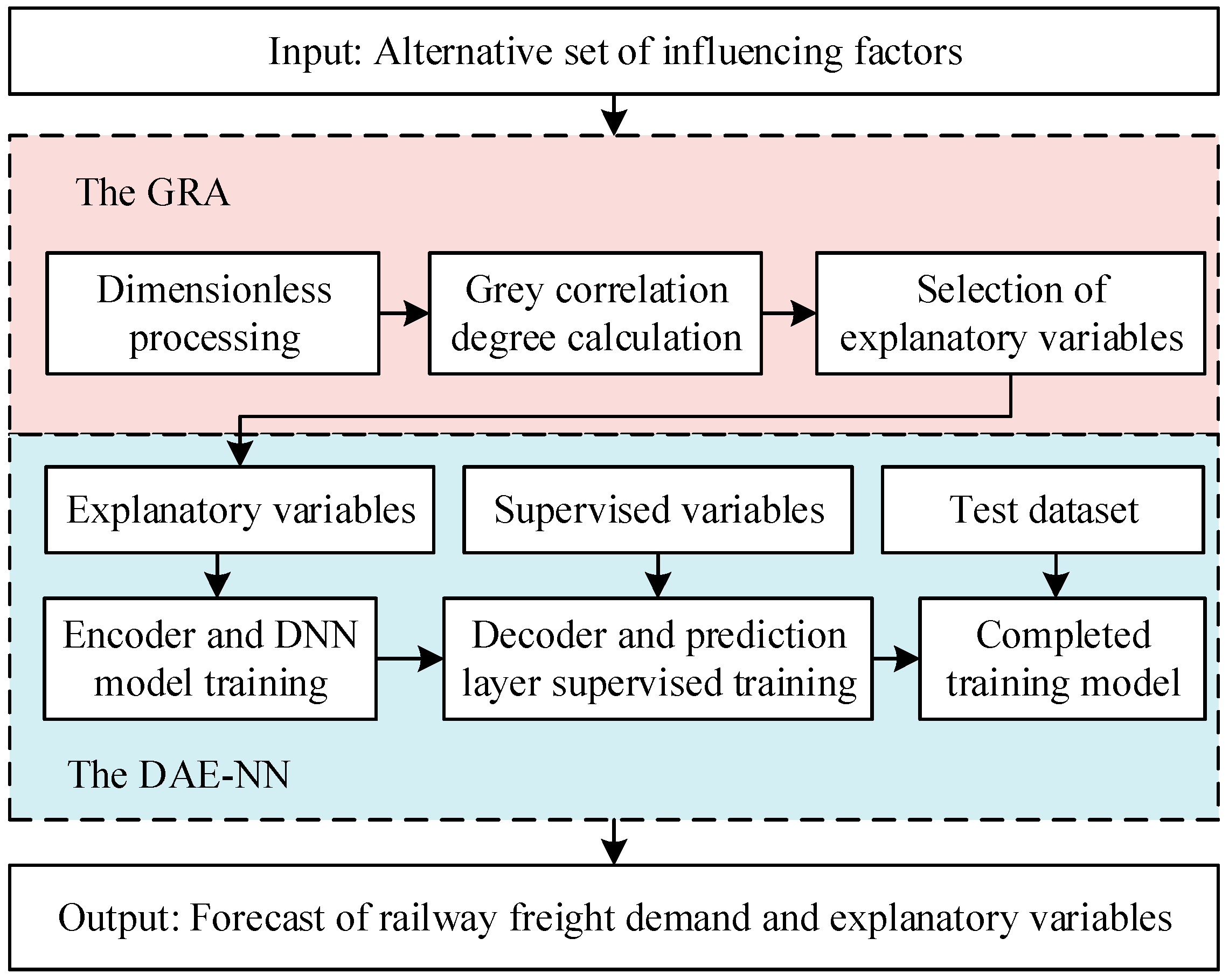

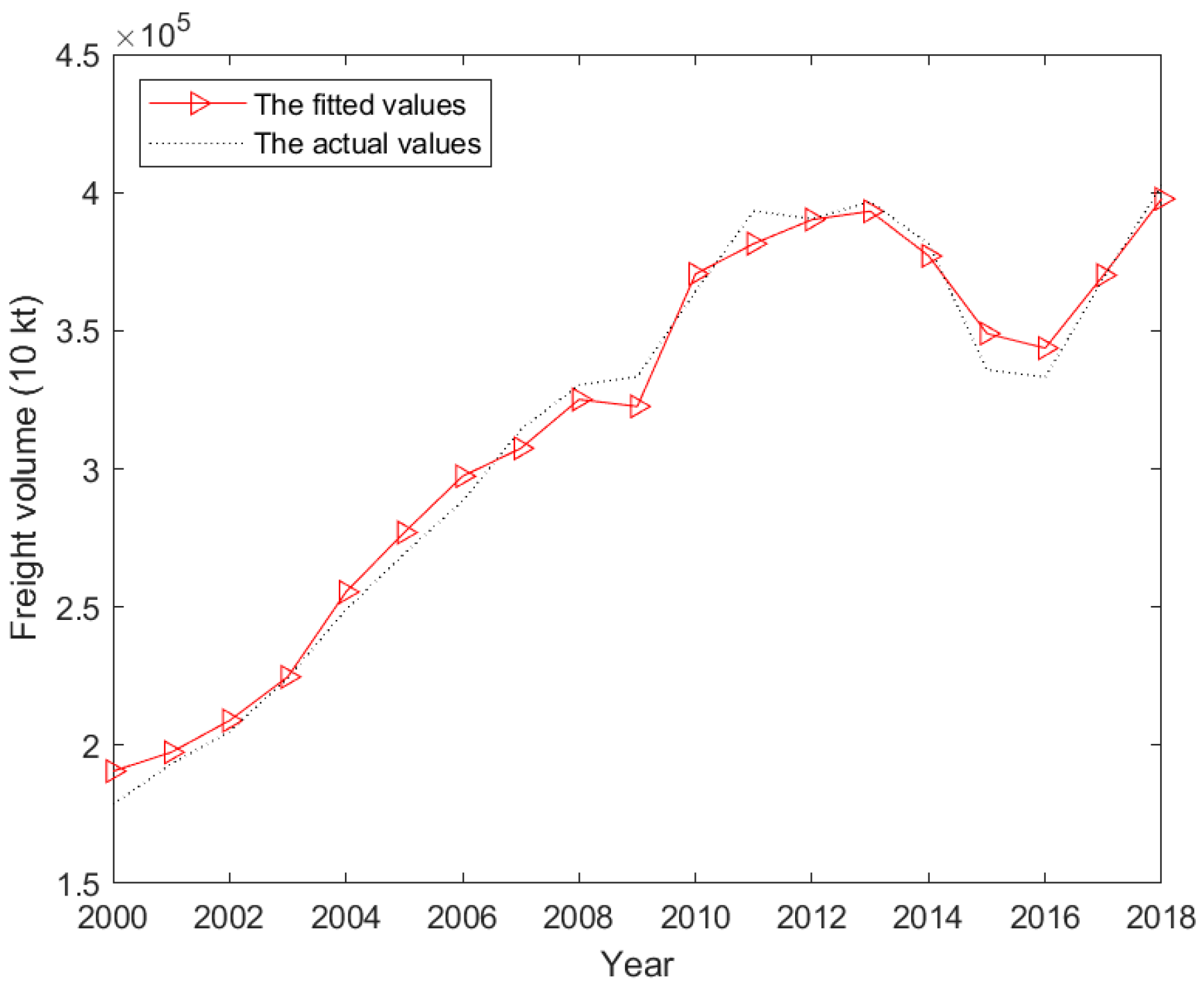
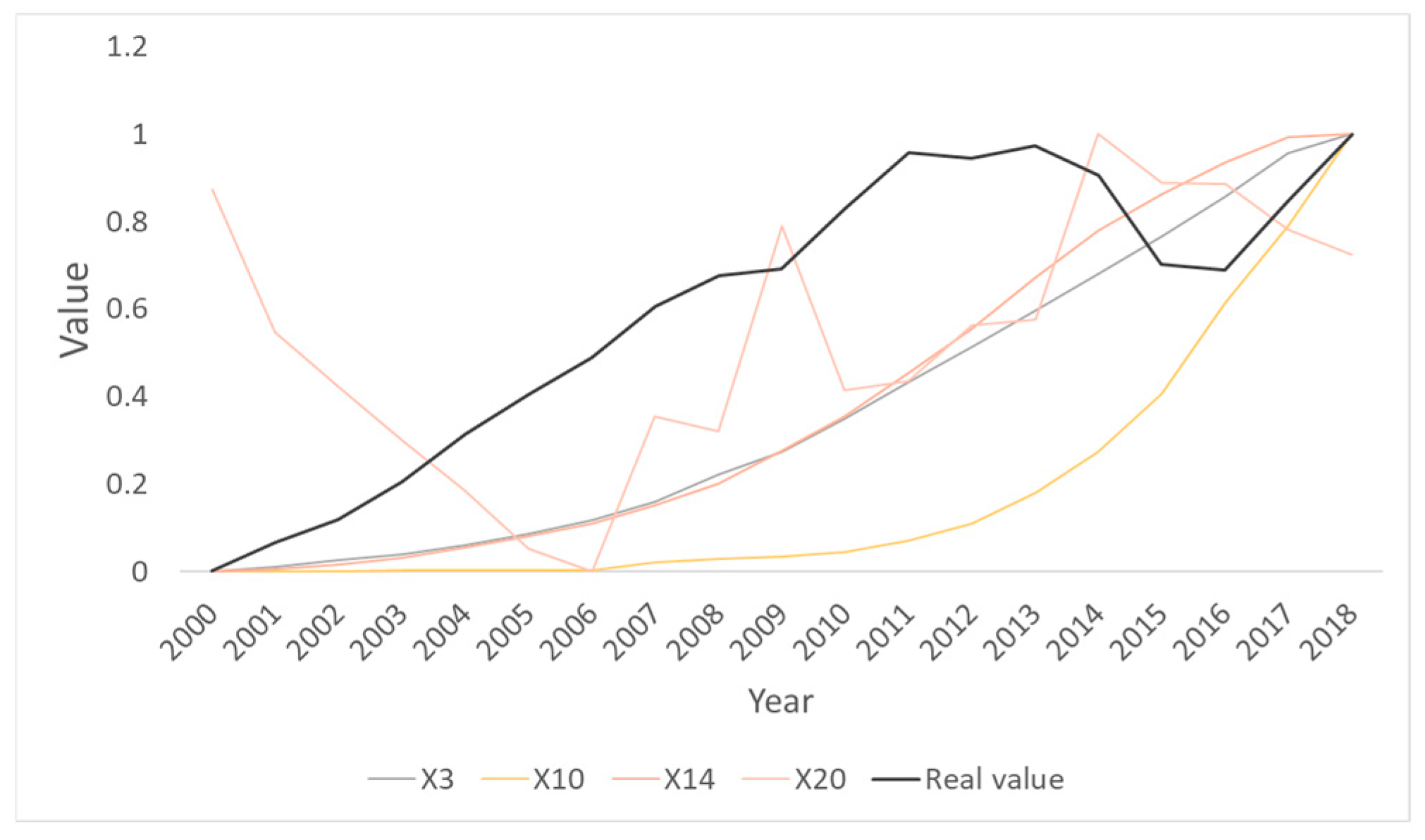

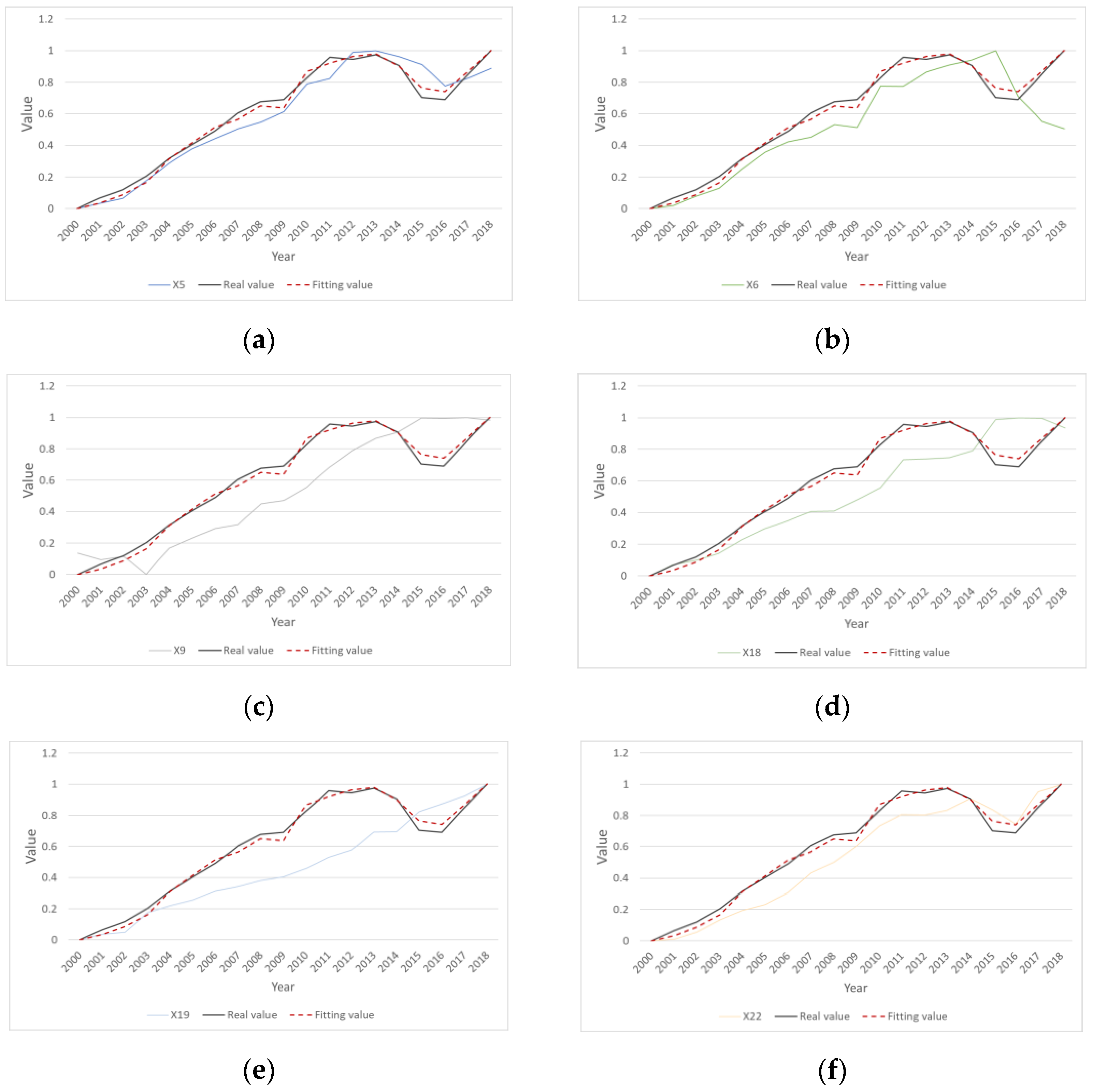
| Classify | Influence Factor | |
|---|---|---|
| Demand | Macroeconomy | Gross domestic product (GDP) () |
| Total value of agricultural output () | ||
| Total retail sales of consumer goods () | ||
| Total volume of merchandise imports and exports () | ||
| Related Industry Production | Coal production () | |
| Petroleum production () | ||
| Steel production () | ||
| Main non-ferrous metal production () | ||
| Grain production () | ||
| Express delivery volume of the year () | ||
| Competitive Context | Freight traffic of highways () | |
| Freight traffic of shipping () | ||
| Civil air cargo volume () | ||
| Supply | Investment in fixed assets in railway transportation () | |
| Length of railroad lines in service () | ||
| National railway electrification mileage () | ||
| Mileage of double track of national railways () | ||
| National railway locomotive inventory () | ||
| National railway freight wagon inventory () | ||
| Number of railway employees () | ||
| Wagon static load () | ||
| Daily production of freight locomotives () | ||
| Demand-Side Influencing | 2000 | 2001 | 2002 | 2003 | 2004 | 2005 | 2006 | 2007 | 2008 | 2009 | |
| Macroeconomy | Gross domestic product (GDP) (billion CNY) | 10,028.01 | 11,086.31 | 12,171.74 | 13,742.20 | 16,184.02 | 18,731.89 | 21,943.85 | 27,009.23 | 31,924.46 | 34,851.77 |
| Total value of agricultural output (billion CNY) | 1387.36 | 1446.28 | 1493.15 | 1487.01 | 1813.84 | 1961.34 | 2152.23 | 2444.47 | 2767.99 | 2998.38 | |
| Total retail sales of consumer goods (billion CNY) | 3910.57 | 4305.54 | 4813.59 | 5251.63 | 5950.10 | 6835.26 | 7914.52 | 9357.16 | 11,483.01 | 13,304.82 | |
| Total volume of merchandise imports and exports (billion DOLLAR) | 474.29 | 644.37 | 814.45 | 984.52 | 1154.60 | 1421.91 | 1760.40 | 2173.83 | 2563.26 | 2207.54 | |
| Related Industry Production | Coal production (ten thousand tons) | 138,418.50 | 147,152.70 | 155,040.00 | 183,489.90 | 212,261.10 | 236,514.60 | 252,855.10 | 269,164.30 | 280,200.00 | 297,300.00 |
| Petroleum production (ten thousand tons) | 16,300.00 | 16,395.90 | 16,700.00 | 16,960.00 | 17,587.30 | 18,135.30 | 18,476.60 | 18,631.80 | 19,044.00 | 18,949.00 | |
| Steel production (ten thousand tons) | 13,146.00 | 16,067.61 | 19,251.59 | 24,108.01 | 31,975.72 | 37,771.14 | 46,893.36 | 56,560.87 | 60,460.29 | 69,405.40 | |
| Main non-ferrous metal production (ten thousand tons) | 783.81 | 883.71 | 1012.00 | 1228.06 | 1441.12 | 1635.00 | 1916.27 | 2379.15 | 2553.63 | 2648.54 | |
| Grain production (ten thousand tons) | 46,217.52 | 45,263.67 | 45,705.75 | 43,069.53 | 46,946.95 | 48,402.19 | 49,804.23 | 50,413.85 | 53,434.29 | 53,940.86 | |
| Express delivery volume of the year (ten thousand piece) | 11,031.40 | 12,652.70 | 14,036.20 | 17,237.80 | 19,772.00 | 22,880.30 | 26,988.04 | 120,189.56 | 151,329.30 | 185,785.81 | |
| Competitive Context | Freight traffic of highways (ten thousand tons) | 1,038,813 | 1,056,312 | 1,116,324 | 1,159,957 | 1,244,990 | 1,341,778 | 1,466,347 | 1,639,432 | 1,916,759 | 2,127,834 |
| Freight traffic of shipping (ten thousand tons) | 122,391 | 132,675 | 141,832 | 158,070 | 187,394 | 219,648 | 248,703 | 281,199 | 294,510 | 318,996 | |
| Civil air cargo volume (ten thousand tons) | 197 | 171 | 202 | 219 | 277 | 307 | 349 | 402 | 408 | 446 | |
| Demand-Side Influencing | 2010 | 2011 | 2012 | 2013 | 2014 | 2015 | 2016 | 2017 | 2018 | ||
| Macroeconomy | Gross domestic product (GDP) (billion CNY) | 41,211.93 | 48,794.02 | 53,858 | 59,296.32 | 64,356.31 | 68,885.82 | 74,639.51 | 83,203.59 | 91,928.11 | |
| Total value of agricultural output (billion CNY) | 3590.907 | 4033.962 | 4484.572 | 4894.394 | 5185.112 | 5420.534 | 5565.989 | 5805.976 | 6145.26 | ||
| Total retail sales of consumer goods (billion CNY) | 15,800.8 | 18,720.58 | 21,443.27 | 24,284.28 | 27,189.61 | 30,093.08 | 33,231.63 | 36,626.16 | 38,098.69 | ||
| Total volume of merchandise imports and exports (billion DOLLAR) | 2972.761 | 3641.938 | 3866.8 | 4160.3 | 4303 | 3956.901 | 3684.914 | 4107.164 | 4622.415 | ||
| Related Industry Production | Coal production (ten thousand tons) | 342,844.7 | 351,600 | 394,512.8 | 397,432.2 | 387,391.9 | 374,654.2 | 339,437 | 352,356.2 | 368,121 | |
| Petroleum production (ten thousand tons) | 20,301.4 | 20,287.6 | 20,747.8 | 20,991.9 | 21,142.9 | 21,455.6 | 19,957.6 | 19,150.6 | 18,907.8 | ||
| Steel production (ten thousand tons) | 80,276.58 | 88,619.57 | 95,577.83 | 108,200.54 | 112,513.12 | 103,468.41 | 104,813.45 | 104,642.05 | 110,551.65 | ||
| Main non-ferrous metal production (ten thousand tons) | 3120.98 | 3628.94 | 3990.33 | 4412.13 | 4828.81 | 5155.82 | 5345.11 | 5498.31 | 5702.68 | ||
| Grain production (ten thousand tons) | 55,911.31 | 58,849.33 | 61,222.62 | 63,048.2 | 63,964.83 | 66,060.27 | 66,043.51 | 66,160.72 | 65,789.22 | ||
| Express delivery volume of the year (ten thousand piece) | 233,891.99 | 367,311.08 | 568,547.99 | 918,674.89 | 1,395,925.3 | 2,066,636.84 | 3,128,315.11 | 4,005,591.91 | 5,071,042.8 | ||
| Competitive Context | Freight traffic of highways (ten thousand tons) | 2,448,052 | 2,820,100 | 3,188,475 | 3,076,648 | 3,113,334 | 3,150,019 | 3,341,259 | 3,686,858 | 3,956,871 | |
| Freight traffic of shipping (ten thousand tons) | 378,949 | 425,968 | 458,705 | 559,785 | 598,283 | 613,567 | 638,238 | 667,846 | 702,684 | ||
| Civil air cargo volume (ten thousand tons) | 563 | 557 | 545 | 561 | 594 | 629 | 668 | 706 | 739 | ||
| Supply | 2000 | 2001 | 2002 | 2003 | 2004 | 2005 | 2006 | 2007 | 2008 | 2009 |
| Investment in fixed assets in railway transportation (billion CNY) | 2622.18 | 3000.12 | 3548.88 | 4581.20 | 5902.80 | 7509.50 | 9336.90 | 11,746.40 | 14,873.80 | 19,392.00 |
| Length of railroad lines in service (ten thousand km) | 6.87 | 7.01 | 7.19 | 7.30 | 7.44 | 7.54 | 7.71 | 7.80 | 7.97 | 8.55 |
| National railway electrification mileage (ten thousand km) | 1.89 | 2.09 | 2.14 | 2.21 | 2.26 | 2.34 | 2.74 | 2.80 | 2.90 | 3.60 |
| Mileage of double track of national railways (ten thousand km) | 2.54 | 2.66 | 2.71 | 2.77 | 2.78 | 2.85 | 2.92 | 2.98 | 3.06 | 3.30 |
| National railway locomotive inventory | 14,472 | 14,955 | 15,159 | 15,456 | 16,066 | 16,547 | 16,904 | 17,311 | 17,336 | 17,825 |
| National railway freight wagon inventory | 439,943 | 453,620 | 459,017 | 510,327 | 526,894 | 541,824 | 564,899 | 577,521 | 591,793 | 601,412 |
| Number of railway employees | 1,871,000 | 1,789,271 | 1,758,421 | 1,727,735 | 1,698,667 | 1,665,588 | 1,652,720 | 1,741,029 | 1,732,909 | 1,850,147 |
| Wagon static load (ton) | 57.90 | 58.10 | 58.20 | 58.30 | 59.30 | 60.10 | 60.90 | 61.30 | 62.00 | 62.60 |
| Daily production of freight locomotives (ten thousand ton-km) | 99.40 | 99.90 | 102.20 | 105.80 | 108.70 | 110.60 | 114.30 | 120.40 | 123.60 | 128.60 |
| Supply | 2010 | 2011 | 2012 | 2013 | 2014 | 2015 | 2016 | 2017 | 2018 | |
| Investment in fixed assets in railway transportation (billion CNY) | 24,143.10 | 30,239.60 | 36,485.40 | 43,574.70 | 50,126.50 | 55,159.00 | 59,650.10 | 63,168.40 | 63,563.60 | |
| Length of railroad lines in service (ten thousand km) | 9.12 | 9.32 | 9.76 | 10.31 | 11.18 | 12.10 | 12.40 | 12.70 | 13.17 | |
| National railway electrification mileage (ten thousand km) | 4.20 | 4.60 | 5.10 | 5.60 | 6.50 | 7.50 | 8.00 | 8.70 | 9.20 | |
| Mileage of double track of national railways (ten thousand km) | 3.70 | 3.90 | 4.40 | 4.80 | 5.70 | 6.50 | 6.80 | 7.20 | 7.60 | |
| National railway locomotive inventory | 18,349 | 19,590 | 19,625 | 19,686 | 19,990 | 21,366 | 21,453 | 21,420 | 21,000 | |
| National railway freight wagon inventory | 622,284 | 651,175 | 670,801 | 715,492 | 716,578 | 768,516 | 788,626 | 808,736 | 839,213 | |
| Number of railway employees | 1,756,385 | 1,761,542 | 1,793,267 | 1,796,382 | 1,902,500 | 1,874,448 | 1,874,131 | 1,848,032 | 1,833,800 | |
| Wagon static load (ton) | 63.10 | 63.60 | 64.00 | 64.40 | 64.60 | 65.00 | 65.20 | 65.60 | 65.70 | |
| Daily production of freight locomotives (ten thousand ton-km) | 135.00 | 138.50 | 138.30 | 139.70 | 143.40 | 139.90 | 135.50 | 145.70 | 147.90 | |
| Classify | Influence Factor | Spearman Correlation | Pearson Correlation | GRA Correlation | |
|---|---|---|---|---|---|
| Demand | Macroeconomy | 0.898 | 0.847 | 0.835158 | |
| 0.896 | 0.869 | 0.876404 | |||
| 0.889 | 0.811 | 0.816226 | |||
| 0.946 | 0.948 | 0.870163 | |||
| Related Industry Output | 0.926 | 0.964 | 0.960872 | ||
| 0.789 | 0.840 | 0.933033 | |||
| 0.926 | 0.943 | 0.87682 | |||
| 0.898 | 0.872 | 0.859417 | |||
| 0.856 | 0.871 | 0.946216 | |||
| 0.898 | 0.593 | 0.674058 | |||
| Competitive Context | 0.892 | 0.890 | 0.902842 | ||
| 0.898 | 0.860 | 0.860545 | |||
| 0.880 | 0.919 | 0.915448 | |||
| Supply | 0.860 | 0.796 | 0.780757 | ||
| 0.898 | 0.778 | 0.93183 | |||
| 0.898 | 0.769 | 0.85042 | |||
| 0.898 | 0.714 | 0.885377 | |||
| 0.860 | 0.886 | 0.941648 | |||
| 0.896 | 0.866 | 0.948876 | |||
| 0.883 | 0.707 | 0.718661 | |||
| 0.898 | 0.936 | 0.925272 | |||
| 0.946 | 0.963 | 0.955143 | |||
| Year | Real Value (Million Tons) | Fitting Value (Million Tons) | Absolute Error (Million Tons) | Relative Error (%) | |
|---|---|---|---|---|---|
| learning sample | 2000 | 1785.81 | 1905.94 | 120.13 | 6.73% |
| 2001 | 1931.89 | 1974.28 | 42.39 | 2.19% | |
| 2002 | 2049.56 | 2089.23 | 39.67 | 1.94% | |
| 2003 | 2242.48 | 2246.98 | 4.5 | 0.20% | |
| 2004 | 2490.17 | 2554.49 | 64.32 | 2.58% | |
| 2005 | 2692.96 | 2769.64 | 76.68 | 2.85% | |
| 2006 | 2882.24 | 2973.19 | 90.95 | 3.16% | |
| 2007 | 3142.37 | 3074.19 | 68.18 | 2.17% | |
| 2008 | 3303.54 | 3250.96 | 52.58 | 1.59% | |
| 2009 | 3333.48 | 3225.78 | 107.7 | 3.23% | |
| 2010 | 3642.71 | 3705.18 | 62.47 | 1.72% | |
| 2011 | 3932.63 | 3814.85 | 117.78 | 2.99% | |
| 2012 | 3904.38 | 3901.8 | 2.58 | 0.07% | |
| 2013 | 3966.97 | 3931.83 | 35.14 | 0.89% | |
| 2014 | 3813.34 | 3770.43 | 42.91 | 1.13% | |
| 2015 | 3358.01 | 3489.44 | 131.43 | 3.91% | |
| 2016 | 3331.86 | 3436.69 | 104.83 | 3.15% | |
| 2017 | 3688.65 | 3700.59 | 11.94 | 0.32% | |
| predicted | 2018 | 4026.31 | 3976.89 | 49.42 | 1.23% |
| Approach | MAPE (%) | MAE (Million Tons) | RMSE (Million Tons) |
|---|---|---|---|
| ARIMA | 5.96% | 173.97 | 189.20 |
| SVR | 4.62% | 134.86 | 142.86 |
| GRU | 6.94% | 202.58 | 223.76 |
| FC-LSTM | 3.35% | 78.60 | 81.63 |
| DNN | 4.68% | 107.42 | 111.42 |
| FNN | 7.42% | 216.59 | 254.41 |
| GRNN | 2.68% | 74.23 | 79.62 |
| The improved GRA-DAE-NN | 2.21% | 64.51 | 74.98 |
| Year | Real Value (Million Tons) | Relative Error (%) | ||
|---|---|---|---|---|
| GRA-DAE-NN | DAE-NN | |||
| learning sample | 2000 | 1785.81 | 6.73% | 12.92% |
| 2001 | 1931.89 | 2.19% | 3.35% | |
| 2002 | 2049.56 | 1.94% | 2.31% | |
| 2003 | 2242.48 | 0.20% | 0.27% | |
| 2004 | 2490.17 | 2.58% | 2.41% | |
| 2005 | 2692.96 | 2.85% | 3.43% | |
| 2006 | 2882.24 | 3.16% | 3.72% | |
| 2007 | 3142.37 | 2.17% | 1.30% | |
| 2008 | 3303.54 | 1.59% | 3.05% | |
| 2009 | 3333.48 | 3.23% | 0.99% | |
| 2010 | 3642.71 | 1.72% | 2.72% | |
| 2011 | 3932.63 | 2.99% | 3.82% | |
| 2012 | 3904.38 | 0.07% | 0.11% | |
| 2013 | 3966.97 | 0.89% | 0.97% | |
| 2014 | 3813.34 | 1.13% | 4.77% | |
| 2015 | 3358.01 | 3.91% | 6.03% | |
| 2016 | 3331.86 | 3.15% | 6.62% | |
| 2017 | 3688.65 | 0.32% | 0.82% | |
| predicted | 2018 | 4026.31 | 1.23% | 4.40% |
| Average | - | 2.21% | 3.37% | |
Disclaimer/Publisher’s Note: The statements, opinions and data contained in all publications are solely those of the individual author(s) and contributor(s) and not of MDPI and/or the editor(s). MDPI and/or the editor(s) disclaim responsibility for any injury to people or property resulting from any ideas, methods, instructions or products referred to in the content. |
© 2023 by the authors. Licensee MDPI, Basel, Switzerland. This article is an open access article distributed under the terms and conditions of the Creative Commons Attribution (CC BY) license (https://creativecommons.org/licenses/by/4.0/).
Share and Cite
Liu, C.; Zhang, J.; Luo, X.; Yang, Y.; Hu, C. Railway Freight Demand Forecasting Based on Multiple Factors: Grey Relational Analysis and Deep Autoencoder Neural Networks. Sustainability 2023, 15, 9652. https://doi.org/10.3390/su15129652
Liu C, Zhang J, Luo X, Yang Y, Hu C. Railway Freight Demand Forecasting Based on Multiple Factors: Grey Relational Analysis and Deep Autoencoder Neural Networks. Sustainability. 2023; 15(12):9652. https://doi.org/10.3390/su15129652
Chicago/Turabian StyleLiu, Chengguang, Jiaqi Zhang, Xixi Luo, Yulin Yang, and Chao Hu. 2023. "Railway Freight Demand Forecasting Based on Multiple Factors: Grey Relational Analysis and Deep Autoencoder Neural Networks" Sustainability 15, no. 12: 9652. https://doi.org/10.3390/su15129652
APA StyleLiu, C., Zhang, J., Luo, X., Yang, Y., & Hu, C. (2023). Railway Freight Demand Forecasting Based on Multiple Factors: Grey Relational Analysis and Deep Autoencoder Neural Networks. Sustainability, 15(12), 9652. https://doi.org/10.3390/su15129652






